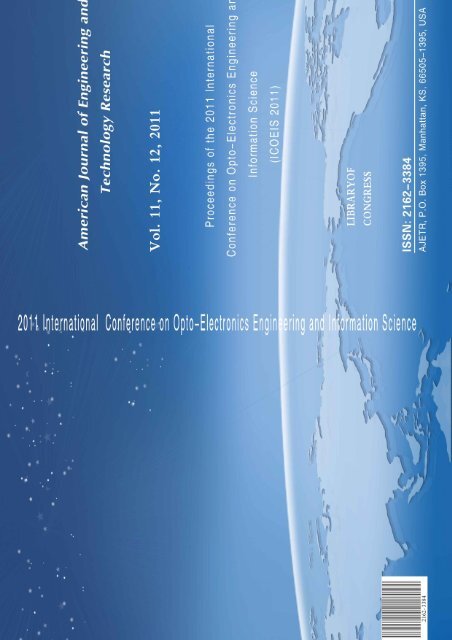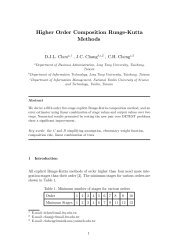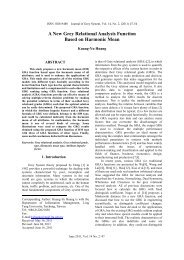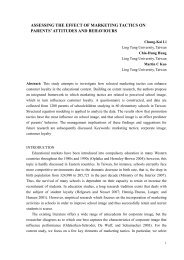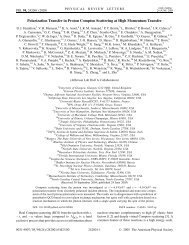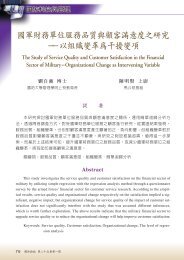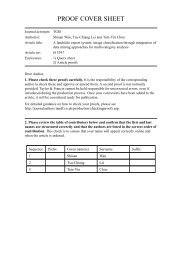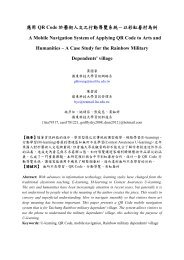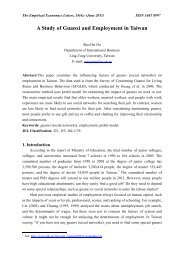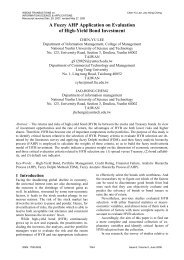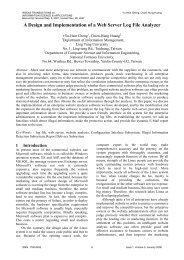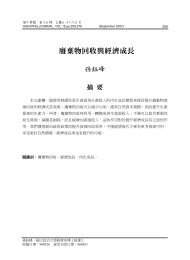American Journal of Engineering and Technology Research
American Journal of Engineering and Technology Research
American Journal of Engineering and Technology Research
You also want an ePaper? Increase the reach of your titles
YUMPU automatically turns print PDFs into web optimized ePapers that Google loves.
<strong>American</strong> <strong>Journal</strong> <strong>of</strong> <strong>Engineering</strong> <strong>and</strong> <strong>Technology</strong> <strong>Research</strong><br />
Vol. 11, No. 12, 2011<br />
Mission<br />
The <strong>American</strong> <strong>Journal</strong> <strong>of</strong> <strong>Engineering</strong> <strong>and</strong> <strong>Technology</strong> <strong>Research</strong> is aimed at providing a platform for researchers,<br />
engineers, scientists, or educators to publish their original research results, to exchange new ideas, to disseminate<br />
information in innovative designs, engineering experiences <strong>and</strong> technological skills. All papers submitted to the<br />
<strong>Journal</strong> will be blind peer-reviewed. Only original articles will be published.<br />
Editorial <strong>and</strong> Review Board<br />
Dr. Chance M. Glenn, Sr.<br />
Pr<strong>of</strong>essor <strong>and</strong> Associate Dean, Office <strong>of</strong> Graduate Studies, Rochester Institute <strong>of</strong> <strong>Technology</strong>, Rochester,<br />
NY 14623, USA<br />
Omar Zia, Ph.D., P.E.,<br />
Pr<strong>of</strong>essor <strong>and</strong> Director <strong>of</strong> Graduate Program ,Department <strong>of</strong> Electrical <strong>and</strong> Computer <strong>Engineering</strong><br />
<strong>Technology</strong>, Southern Polytechnic State University, GA 30060, USA<br />
Dr. George Yang<br />
Pr<strong>of</strong>essor <strong>and</strong> Chair, Department <strong>of</strong> <strong>Engineering</strong> <strong>Technology</strong>, Missouri Western State University, St.<br />
Joseph, MO 64507, USA<br />
Dr. Samir El-Omari<br />
Assistant Pr<strong>of</strong>essor, Department <strong>of</strong> Industrial Studies, University <strong>of</strong> Wisconsin, Platteville, WI 53818, USA<br />
Dr. Samadhan J Jadhao<br />
Indian Veterinary <strong>Research</strong> Institute, India<br />
Dr. Dr. Jones Olajide.<br />
Adjunct Pr<strong>of</strong>essor, Argosy University at Washington DC, Arlington, VA 22209, USA<br />
Dr. Allan Ayella<br />
Pr<strong>of</strong>essor <strong>and</strong> Head, Department <strong>of</strong> Natural Science, McPherson College, McPherson, KS 67460, USA<br />
Dr. M.M. Wang<br />
System Engineer, Beth Israel Deaconess Medical Center, Harvard Medical School,. Boston, MA 02461,<br />
USA<br />
Dr. Rungun R Nathan<br />
Assistant Pr<strong>of</strong>essor, Division <strong>of</strong> <strong>Engineering</strong>, Business <strong>and</strong> Computing, Penn State University - Berks,<br />
Reading, PA 19610, USA<br />
Dr. H.Y. Huang<br />
Assistant Pr<strong>of</strong>essor, Department <strong>of</strong> Foreign Languages, The United States Military Academy, West Point,<br />
NY 10996, USA<br />
Dr. Xiaorong Wu,<br />
<strong>Research</strong> Assistant Pr<strong>of</strong>essor, Department <strong>of</strong> Bio <strong>and</strong> Agricultural <strong>Engineering</strong>, Kansas State University,<br />
Manhattan, KS 66506, USA<br />
Disclaimer<br />
By submitting a paper or an article to the <strong>American</strong> <strong>Journal</strong> <strong>of</strong> <strong>Engineering</strong> <strong>and</strong> <strong>Technology</strong> <strong>Research</strong> (AJETR),<br />
author(s) agrees that copyright <strong>of</strong> the paper or article is provided to AJETR for the purpose <strong>of</strong> publishing, author(s)<br />
owns <strong>and</strong> keeps the copyright. Although, all publications by AJETR are peer-reviewed, AJETR can not guarantee<br />
their accuracy or correctness. AJETR is not responsible for any plagiarism claim, it is the sole liability <strong>of</strong> the<br />
author(s). AJETR reserves the right to retrieve any or all publications.<br />
U.S. Library <strong>of</strong> Congress Registered<br />
ISSN: 2162-3384<br />
AJETR, P.O. Box 1395, Manhattan, KS, 66505-1395, USA<br />
www.ajetr.org
<strong>American</strong> <strong>Journal</strong> <strong>of</strong> <strong>Engineering</strong> <strong>and</strong> <strong>Technology</strong> <strong>Research</strong><br />
ISSN 2162-3384<br />
Table <strong>of</strong> Contents(Part IV)<br />
2011 | Volume 11 | Number 12<br />
Study on the Prediction Model <strong>of</strong> Paper printability in Ink-jet Printing 1<br />
Chen Shuang-lian,Chen Guang-xue*, Chen Qi-feng, Qu Zhen-cai,Xu Rui-xin<br />
A Monitor Calibration Model Based on Artificial Neural Network 5<br />
Zhao Lei, Chen Guang-xue,Tang Bao-ling, Xu Rui-xin<br />
Strain monitoring <strong>of</strong> T-stiffened panels subjected to low-velocity impact using<br />
9<br />
embedded FBG sensors<br />
Zhou Yujing, Liu Gang, Li Xueqin, Yi Xiaosu<br />
3D Finite Element Analysis <strong>of</strong> Single Cylinder Diesel Engine Crankshaft 13<br />
Bin Zheng, Yongqi Liu, Ruixiang Liu, Jian Meng<br />
Study on Polyurethane-acrylic Hybrid Emulsion Applying to Waterbased Ink 17<br />
Tai Jinglei, Chen Guangxue, Chen Qifeng, Tang Baoling<br />
A modified PSO-BP algorithm in hydraulic system fault diagnosis application 21<br />
Zengshou Dong, Xiaoyu Zhang,Jianchao Zeng<br />
Reexamining Mean Score as the Best Index 24<br />
Kee-Kuo Chen<br />
Biomechanical Analysis <strong>of</strong> Two Techniques Performed in Table Tennis 28<br />
Bi-jian Mao<br />
The Model <strong>and</strong> Simulation <strong>of</strong> Trust System in Distributed Collaborative Environment 31<br />
Lu You, Hua Ze,Xi Xuefeng<br />
A Mesh Topology Approach for Bluetooth Scatternet Formation 36<br />
Chih-Min Yu, Jyun-Hong Lin<br />
Improving the Compression Strength after Impact <strong>of</strong> RTM Composites by<br />
40<br />
Interlaminar Thermoplastic Nonwoven Fabric<br />
Peng Zhang, Gang Liu, Xiaolan Hu, Wenming Zhao, Xiaosu Yi<br />
A Configurable Routing Protocol For Bluetooth Wireless Networks 44<br />
Chih-Min Yu1, Jing-Rung Yu<br />
<strong>Research</strong> <strong>and</strong> improvement <strong>of</strong> Live-Wire Interactive Algorithm for Medical Image 48<br />
Segmentation<br />
Li Ji-ying, Dang Jian-wu<br />
Multi-channel Voltage Pulse Testing Based on Lab Windows/CVI 51<br />
Zhao Yi, Guo Hui-bing<br />
Design <strong>and</strong> Application <strong>of</strong> Online Testing System Based on Fuzzy Mathematics 54<br />
Limin<br />
Optimum Digital Filter for High-Performance All-Digital Phase-Locked Loop 58<br />
Huafang Sun, Xinning Liu, Xin Chen<br />
A Piecewise Function Smooth Strength Envelope Model 63<br />
Zhang Leiyu, Zhuo ruihua, Liu Lijian,Feng Shuzhong<br />
Study the Ferro-Hydrodynamic Characteristic on FHD Bernoulli Model 68<br />
Je-Ee.Ho<br />
Assessing the stock price variation based on the DOE-based optimization <strong>of</strong> neural 72<br />
network<br />
Ling Feng Hsieh, Su Chen Hsieh ,Pei Hao Tai<br />
Indictors <strong>of</strong> E-decision Making Competence for College Students 76<br />
Pi-Shan Hsu, Ming-Wen Chang, Chien-Yun Dai, Joni Tzuchen Tang, Te-Jeng Chang<br />
I
Factors Affecting the Consumer’s Adopting <strong>of</strong> Self Service <strong>Technology</strong>--- a Case 704<br />
Study <strong>of</strong> iBon<br />
Chuen-Roan Kang, Shung-Ming Tang<br />
A Study <strong>of</strong> Using Computer Programming into Science Instruction for 5 th Graders in 708<br />
Taipei<br />
Ching-san Lai, Ming-horng Lai<br />
A Novel Approach for Disambiguating Chinese Homographs 711<br />
Feng-Long Huang<br />
The use <strong>of</strong> image processing in Athletic Analysis 716<br />
Lee, Yan-Pu, Chen,Wu-Chou, Jhao,Shih-Bin<br />
A Novel Algorithm for Key Frames Selection 720<br />
Chen-Kuei Yang, Shyi-Chyi Cheng<br />
The Information Database <strong>and</strong> Computer-aided Urban Planning System Frameworks 724<br />
Depending on Control Flexibility <strong>of</strong> Three Dimensional L<strong>and</strong> Development<br />
Chi Chiang Hsieh, Yung Mao Shieh, Wen Pin Huang, Chien Fu Huang<br />
Computer Science St<strong>and</strong>s for Efficiency or Exploited? A Study <strong>of</strong> Organization-Job 729<br />
Fit <strong>of</strong> Taiwan News staff<br />
Chih Yang Chao, Chia Sung Yen, Shih Chun Yang<br />
Performance Tuning on the Http-Redirection Dispatcher 733<br />
Jwu-Jenq Chen, Wen-Kui Chang, Tzyy-Chau Yu, Hsaio-Hsuan Chang<br />
Constructing The <strong>Technology</strong> Transaction Model 737<br />
Hui-Hua Ou-Yang<br />
The New Preference <strong>of</strong> Viewfinder <strong>Technology</strong> 742<br />
Wei-Ming Yeh<br />
The New Study <strong>of</strong> VR Effects <strong>Technology</strong> 746<br />
Wei-Ming Yeh<br />
Application <strong>of</strong> the Construction Method <strong>of</strong> Oil Exploration <strong>and</strong> Development Domain 750<br />
Ontology Based on a Multi-level Business Process<br />
Deng Xiao-ya<br />
<strong>Research</strong> on vacuum sling technology <strong>of</strong> aeronautical aluminum alloy low-rigid 754<br />
parts<br />
Chunlin Fu, Tiegang Li, Wanshan Wang<br />
Design <strong>and</strong> Implementation <strong>of</strong> Derivation Cryptographic Algorithms in Embedded 758<br />
Contactless IC Card System<br />
Xiangqun Fang, Haibo Ge, Ping Li<br />
Discussion on the Construction <strong>of</strong> New Generation Campus Data Center 762<br />
Guibin Ma<br />
<strong>Research</strong> <strong>and</strong> Implementation <strong>of</strong> Enterprise Application Integration Based on SOA 766<br />
Zhuang Wu, Yan Li<br />
Theory <strong>and</strong> Application <strong>of</strong> F-MASK Hyper-connectivity operator Based on Multi-Harr 770<br />
wavelets<br />
Cai Hui<br />
A Fast Algorithm for Lip Contour <strong>and</strong> Feature Extraction 774<br />
Xibin Jia , Kewei Zhang<br />
Genetic Algorithm using the Bimodal Operation to Prevent Prematurity <strong>and</strong> Reduce 778<br />
Computational Time<br />
Ling-Tzu Tseng<br />
Using DEMATEL Method to Explore the Causal Relationship <strong>of</strong> Criteria for Foods 782<br />
Supplier Selection: An Empirical Case Study<br />
Jung-Lu Shen, Yong-Mei Liu, Yi-Ling Tzeng<br />
An Ant Colony Algorithm Method for Multi-objective Production System 786<br />
Chun-Hsiung Lan, Kuo-Torng Lan ,Tzu-Ying Hung<br />
EIS Development for Medical Quality Improvement 789<br />
IX
<strong>American</strong> <strong>Journal</strong> <strong>of</strong> <strong>Engineering</strong><br />
<strong>and</strong> <strong>Technology</strong> <strong>Research</strong><br />
Vol. 11, No.12, 2011<br />
The Information Database <strong>and</strong> Computer-aided Urban Planning System<br />
Frameworks Depending on Control Flexibility <strong>of</strong> Three Dimensional<br />
L<strong>and</strong> Development<br />
Chi Chiang Hsieh 1 , Yung Mao Shieh 1 , Wen Pin Huang 2 , Chien Fu Huang 3<br />
1.Dept. <strong>of</strong> Tourism & Leisure Management, Ling Tung University, Taichung City, Taiwan, R.<br />
O. C. hcc@teamail.ltu.edu.tw, sym@teamail.ltu.edu.tw<br />
2.Dept. <strong>of</strong> Architecture, Feng Chia University, Taichung City, Taiwan, R. O. C.<br />
arwbin@ms21.hinet.net<br />
3.General Education Center, Ling Tung University, Taichung City, Taiwan, R. O. C.<br />
ltu1400@teamail.ltu.edu.tw<br />
Abstract. As progressive improvement <strong>of</strong> science <strong>and</strong> technology, the urban development <strong>and</strong> l<strong>and</strong> use activities<br />
become increasingly complex therefore the features <strong>of</strong> planning tools extended to three-dimension dem<strong>and</strong> <strong>and</strong><br />
flexibility obviously. Since 2005, the T.D.R. system has been adopted in Taichung City. It forced the l<strong>and</strong> development<br />
right toward to tradable <strong>and</strong> severable. Meantime, also created negative impacts <strong>of</strong> transaction cost, security <strong>and</strong><br />
environmental externalities, eventually resulted in complexity <strong>of</strong> urban growth control quotas <strong>and</strong> management policies.<br />
As above background, this article combines method <strong>of</strong> content analysis <strong>and</strong> focus-group interview with aims to discuss<br />
how to construct the practical G.I.S. <strong>and</strong> the computer-aided urban planning system. It includes not only provision <strong>of</strong><br />
sufficient market information, but also dynamic guidance to the l<strong>and</strong> development. Final attempt to achieve three main<br />
goals: The efficiency <strong>of</strong> l<strong>and</strong> use, service quality <strong>of</strong> public facility <strong>and</strong> quality <strong>of</strong> living environment.<br />
Keywords: Geographic Information System (G.I.S.), Computer-aided System, Urban Planning.<br />
1. Introduction<br />
Faces the rapid scientific <strong>and</strong> technological improvement <strong>and</strong> changes in l<strong>and</strong> development, government<br />
departments need to update planning control system in aspect <strong>of</strong> supply, management <strong>and</strong> planning techniques as to<br />
meet institutional dem<strong>and</strong>. Since progressive improvement <strong>of</strong> construction techniques <strong>and</strong> technology, the urban<br />
development <strong>and</strong> l<strong>and</strong> use activities become increasingly complex therefore the planning controls is required to three<br />
dimensions <strong>and</strong> flexibility obviously. In consideration <strong>of</strong> various complexity <strong>of</strong> dem<strong>and</strong> <strong>and</strong> supply, a flexible l<strong>and</strong>-use<br />
planning needs to be conducted based on comparatively-loose individual network <strong>and</strong> to be integrated to an open,<br />
flexible <strong>and</strong> reasonable model [1, 2].<br />
Taichung city, located in heart <strong>of</strong> central Taiwan, benefited from the direct air links between Taiwan <strong>and</strong> China,<br />
accessibility <strong>of</strong> high speed railway <strong>and</strong> the upgrade <strong>of</strong> municipal city that led to further rise <strong>of</strong> real estate development<br />
activities. In response to above policies <strong>and</strong> development needs, Transferable Development Rights (T.D.R.) was<br />
implemented since 2005 as to enhance severability <strong>and</strong> tradability <strong>of</strong> l<strong>and</strong> development rights. Meantime it also<br />
impacted to transaction security, environmental externalities <strong>and</strong> investment location, even became more complicated<br />
such as the policies <strong>of</strong> urban growth control quotas <strong>and</strong> management [1]. This article focuses on implementation <strong>of</strong><br />
T.D.R. in Taichung City, especially how to provide adequate information systems in both supply <strong>and</strong> dem<strong>and</strong>, thereby<br />
to construct dynamic planning patterns <strong>and</strong> control <strong>of</strong> three dimensional l<strong>and</strong> development for timely response <strong>and</strong><br />
adjustment.<br />
2. Materials <strong>and</strong> Methods<br />
This article reviews actual mechanism implementation <strong>of</strong> T.D.R. in Taichung City during 2005-2010. The location<br />
& quantity <strong>of</strong> T.D.R. received areas in Taichung City Shown in Fig. 1 is an uneven spatial distribution patterns. The<br />
content analysis <strong>and</strong> focus group interview are adopted as to a further discussion <strong>of</strong> how to achieve urban planning<br />
objectives particularly the balance between efficiency <strong>of</strong> l<strong>and</strong> use, service quality <strong>of</strong> public facilities <strong>and</strong> quality<br />
st<strong>and</strong>ard <strong>of</strong> living environment. This article attempts to conduct appropriate framework through urban geographic<br />
information system <strong>and</strong> the computer-aided planning system. With hope <strong>of</strong> the future enhancement <strong>of</strong> these systems that<br />
to assist public sector can fully grasp information through mentioned dynamical integration platform. To provide<br />
inquiry service <strong>of</strong> market information, it can be appropriate guidance for l<strong>and</strong> developers <strong>and</strong> to make market<br />
information to public <strong>and</strong> symmetry. Also the adoption <strong>of</strong> dynamic planning model to enhance the effectiveness <strong>and</strong><br />
rationality <strong>of</strong> urban planning system particularly a timely response <strong>and</strong> adjustment for l<strong>and</strong> control.<br />
724
<strong>American</strong> <strong>Journal</strong> <strong>of</strong> <strong>Engineering</strong><br />
<strong>and</strong> <strong>Technology</strong> <strong>Research</strong><br />
Vol. 11, No.12, 2011<br />
Fig. 1 The Location & Quantity Distribution <strong>of</strong> T.D.R. Received Areas in Taichung City<br />
The focus group interview is a brainstorming method, through the interaction process from groups <strong>of</strong> industry<br />
operators, <strong>of</strong>ficials <strong>and</strong> academics. The creation <strong>of</strong> chain interaction such as the B<strong>and</strong>wagon Effect with specialized,<br />
synergism <strong>and</strong> spontaneity, to provide a comprehensive perspective <strong>of</strong> the theme [3] . For size <strong>of</strong> focus group interview,<br />
this article refers to Richey <strong>and</strong> relevant studies, the case <strong>of</strong> a single or group topics for study, the small groups (such as<br />
8 to 15 persons) is the effective size to reach consensus [4]. Best also proposed more comprehensive view that public<br />
consensus generated from five or more participants, it could be better than the individual [5]. The market structure <strong>of</strong><br />
T.D.R. in Taichung City is shown in Fig. 2. As above, 8 experts are invited to the forum, including 3 <strong>of</strong>ficers (Taichung<br />
City Government, Urban Plan Committee & Urban Design Committee), 2 scholars (Expert Advisory Group) <strong>and</strong> 3<br />
members from industry (The L<strong>and</strong> Broker, Builder <strong>and</strong> Architects Association).<br />
Fig. 2 The Market Structure <strong>and</strong> Operation <strong>of</strong> T.D.R. in Taichung City<br />
725
<strong>American</strong> <strong>Journal</strong> <strong>of</strong> <strong>Engineering</strong><br />
<strong>and</strong> <strong>Technology</strong> <strong>Research</strong><br />
Vol. 11, No.12, 2011<br />
3. The Framework <strong>of</strong> UGIS-based Database<br />
According to the Act, Taichung City Government needs to check all private reservations for public facilities, then to<br />
draw the atlas <strong>of</strong> transferable sent sites. It includes: (1) The type, nature <strong>and</strong> size <strong>of</strong> public facility reservations. (2) The<br />
overlays <strong>of</strong> transferable sent sites located in the urban planning <strong>and</strong> cadastral map. (3) Relevant stipulations under the<br />
Act. First <strong>of</strong> all, through focus group interview to reach consensus, also the query <strong>and</strong> M.I.S. is necessary to combine<br />
with G.I.S. <strong>and</strong> l<strong>and</strong> administration systems (consist <strong>of</strong> the cadastral map, l<strong>and</strong> management <strong>and</strong> l<strong>and</strong> registration<br />
database). Above data should be exclusively integrated into institutional structure as key element <strong>of</strong> the framework <strong>of</strong><br />
UGIS-based database. The system function could be exp<strong>and</strong>ed with input from institution characteristics, market<br />
transactions <strong>and</strong> actual dem<strong>and</strong>s. The concluded consensus <strong>and</strong> ideas through focus groups interview as shown in Fig.<br />
3.<br />
Checking<br />
Recognizing<br />
Case Application<br />
Digital Cadastral Map<br />
Transferable Sent<br />
Site Distribution<br />
Geo-data <strong>of</strong><br />
Urban Planning<br />
Topographic Map<br />
Local Government<br />
W. W. W.<br />
T.D.R.Dedicated<br />
Website<br />
Cases Approved<br />
Access Database<br />
L<strong>and</strong> Management System,<br />
Cadastral Database, …<br />
T.D.R. Database<br />
Exporting<br />
Access Database<br />
Market Trading<br />
Information<br />
Transferable Sent<br />
Sites Atlas<br />
Fig. 3 The Framework <strong>of</strong> UGIS-based Database for T.D.R.<br />
In addition to basic functions, the management departments can further apply the advanced query function <strong>of</strong><br />
database, to share potential information <strong>of</strong> dem<strong>and</strong> <strong>and</strong> supply, afterwards the administrative departments can<br />
continuously provide the necessary services <strong>of</strong> information, co-ordination <strong>and</strong> advisory to potential traders. Then the<br />
suppliers <strong>and</strong> dem<strong>and</strong>ers can complete transactions through negotiation <strong>of</strong> size <strong>and</strong> price on their own. This system is<br />
exp<strong>and</strong>able through the integration <strong>of</strong> related data, calculations. It can help potential traders particularly who have<br />
expression <strong>of</strong> intent to move into transferable zone with conditions. After information screening through conversion <strong>of</strong><br />
existed formula, it can preliminary select the possible transaction object.<br />
4. The Framework <strong>of</strong> Computer-aided Urban Planning System<br />
In response to foregoing impacts <strong>and</strong> issues <strong>of</strong> T.D.R., through this focus group interview to reach consensus, <strong>and</strong><br />
the M.I.S. for T.D.R. which must be combined with dynamic planning model then feedback to the urban growth control<br />
quotas <strong>and</strong> management policies. This M.I.S. can contribute assistance to local government when estimating the<br />
potential T.D.R. receiving areas for instance <strong>of</strong> controlling changes to the st<strong>and</strong>ard <strong>of</strong> living environment <strong>and</strong> carrying<br />
capacity <strong>of</strong> public facilities. On this basis, the R&D departments will be able to develop further computer-aided urban<br />
planning system then support the planning departments to improve the structural negative impacts during discussion in<br />
726
<strong>American</strong> <strong>Journal</strong> <strong>of</strong> <strong>Engineering</strong><br />
<strong>and</strong> <strong>Technology</strong> <strong>Research</strong><br />
Vol. 11, No.12, 2011<br />
this forum, such as “The disorder between overall urban development quotas <strong>and</strong> growth management”, “The lack <strong>of</strong><br />
provisions <strong>of</strong> market incentive in guiding suitable location for development”, “The lack <strong>of</strong> information circulation &<br />
compensation mechanism <strong>of</strong> T.D.R. receiving area” <strong>and</strong> “Necessity <strong>of</strong> polices integration for guiding to a reasonable<br />
pattern <strong>of</strong> the urban spatial structure”.<br />
This article integrates the results <strong>of</strong> focus group interviews in topics <strong>of</strong> policies, systems <strong>and</strong> operations <strong>of</strong> urban<br />
planning. The practical concept <strong>of</strong> development planning framework <strong>and</strong> the support system is shown in Fig. 4.<br />
Further consideration in long-term scale, the T.D.R. receiving areas may be extended to new dem<strong>and</strong> for public<br />
facilities. It needs full evaluation <strong>of</strong> dem<strong>and</strong> <strong>and</strong> overcrowding problem through further review, assessment <strong>and</strong> plan<br />
beforeh<strong>and</strong>. The government <strong>and</strong> developer should mutually bear the burden <strong>of</strong> construction costs in proper proportion<br />
basis mutually. Furthermore, after tendency preview <strong>of</strong> demographic, social, economic <strong>and</strong> spatial changes in Taiwan,<br />
the planners need to guide a continuous <strong>and</strong> compact management model for urban spatial development. Therefore, the<br />
system can be further advanced such as urban regeneration, urban design <strong>and</strong> other institutions; To towards a more<br />
extensively-integrated databases <strong>and</strong> platforms, it requires a closely-connected multidimensional tool as to setup<br />
supporting measures; To conduct proper guidance for l<strong>and</strong> developers, <strong>and</strong> the co-creation <strong>of</strong> effectiveness <strong>and</strong><br />
sustainability for urban development.<br />
Fig. 4 The framework <strong>of</strong> computer-aided urban planning system for T.D.R.<br />
5. Conclusions<br />
T.D.R. is the important beginning to promote flexibility <strong>of</strong> l<strong>and</strong> development control in three-dimension basis in<br />
Taiwan. It also creates the negative impacts <strong>of</strong> transaction cost <strong>and</strong> security. However, current institution lacks <strong>of</strong> clear<br />
rules to appropriately designate the received area. Recent tendency <strong>of</strong> urban l<strong>and</strong> use, the market-led strength that<br />
towards to more concentrated locations. It has worsened the problems for instance <strong>of</strong> service quality <strong>of</strong> transportations,<br />
l<strong>and</strong> uses <strong>and</strong> public facilities in some popular areas. This article takes Taichung City as most representative case <strong>of</strong><br />
Taiwan. Firstly starts with focus group interviews <strong>of</strong> industrial, <strong>of</strong>ficial <strong>and</strong> academic groups. All forum members have<br />
widely discussion <strong>of</strong> how to provide sufficient information to market in basis <strong>of</strong> open, adequate <strong>and</strong> symmetric, <strong>and</strong><br />
then to build the framework <strong>of</strong> computer-aided urban planning system.<br />
Timing <strong>and</strong> reason <strong>of</strong> such critical institutional changes in Taiwan, the planners <strong>and</strong> managers need better solutions<br />
based on rational <strong>and</strong> traditional planning concept <strong>of</strong> blueprint model. In early stages <strong>of</strong> T.D.R., the local governments<br />
must proceed to integrate <strong>and</strong> exp<strong>and</strong> the urban geographic information system <strong>and</strong> other resources, consecutively build<br />
the UGIS-based database. Furthermore, local governments may focus on the application <strong>of</strong> relevant techniques <strong>and</strong> the<br />
development <strong>of</strong> computer-aided urban planning system in order to mitigate the impact <strong>of</strong> urban l<strong>and</strong> development<br />
conflict <strong>and</strong> externalities. This article has proposed the basic requirements <strong>and</strong> framework <strong>of</strong> aforementioned database<br />
<strong>and</strong> system, this study will also continue the exploration in subsequent rounds <strong>of</strong> discussion in relation to application <strong>of</strong><br />
more specific modules <strong>and</strong> technologies.<br />
727
<strong>American</strong> <strong>Journal</strong> <strong>of</strong> <strong>Engineering</strong><br />
<strong>and</strong> <strong>Technology</strong> <strong>Research</strong><br />
Vol. 11, No.12, 2011<br />
References<br />
[1] Hsieh, C. C. <strong>and</strong> Juang, H. H.: The Niche Characteristic <strong>of</strong> Urban L<strong>and</strong> Use Strength in Taichung City- A Case<br />
Study <strong>of</strong> T.D.R.. <strong>Journal</strong> <strong>of</strong> Geographical <strong>Research</strong> Vol. 51 (2009), p.23-43.<br />
[2] Hopkins, L. D.: Urban development: the logic <strong>of</strong> making plans (Isl<strong>and</strong>, Washington DC 2001).<br />
[3] Berg, B. L.: Qualitative research methods for the social sciences (Allyn & Bacon, Boston 1998).<br />
[4] Richey, Charles R.: Manual on employment discrimination <strong>and</strong> civil rights actions in the federal courts (Kluwer<br />
Law, New York 1985).<br />
[5] Best, J. R.: Market-Based Management (Feynman, New York 2006).<br />
[6] Information on http://www.taichung.gov.tw<br />
728


